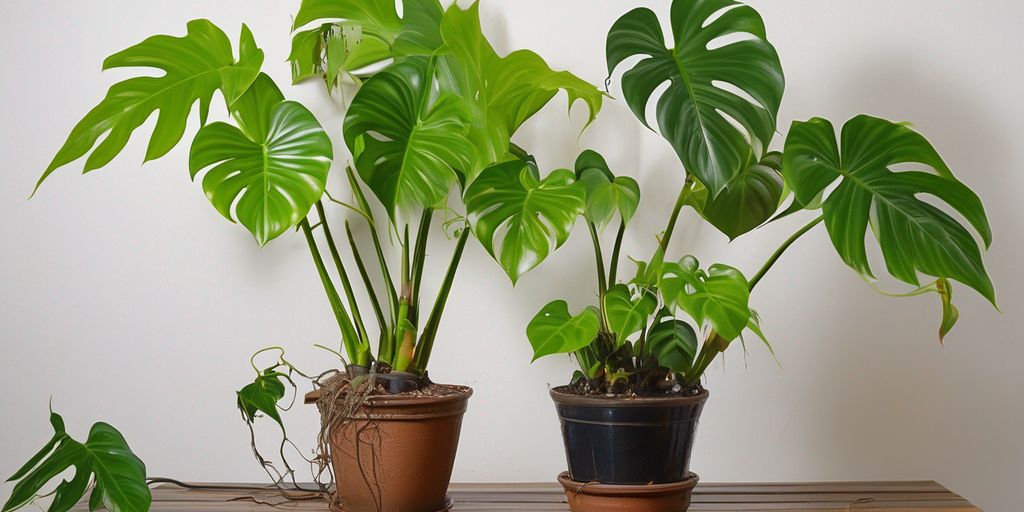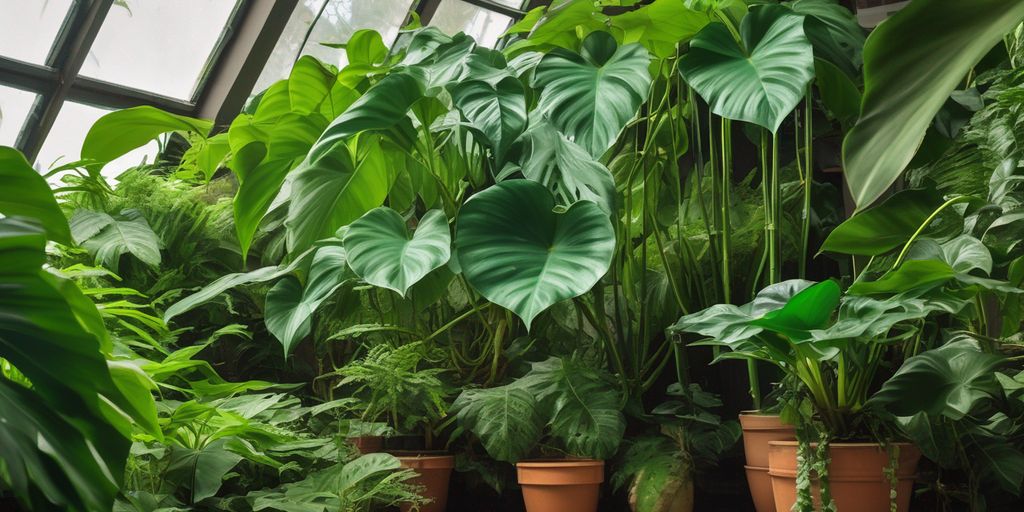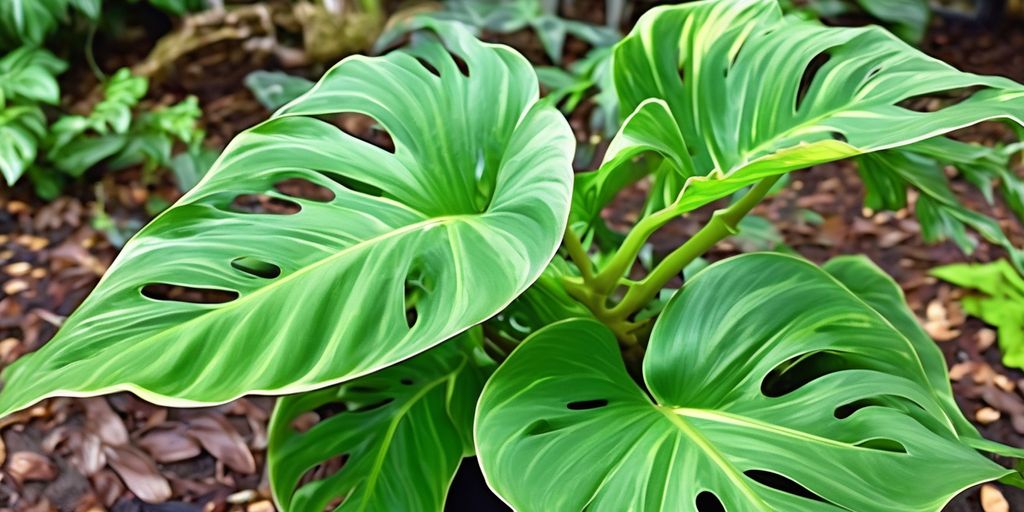Reviving an overwatered Philodendron ‘Hope’ involves recognizing the signs of overwatering and taking appropriate steps to mitigate the damage. This article provides practical tips and tricks to help your Philodendron recover and thrive, ensuring it receives the right amount of water and care.
Contents
- 1 Identifying Signs of an Overwatered Philodendron
- 2 Immediate Actions to Rescue Your Overwatered Philodendron
- 3 Root Care for Recovery
- 4 Optimal Watering Techniques
- 5 Preventing Future Overwatering
- 6 Understanding the Needs of Philodendron ‘Hope’
- 7 Advanced Care Tips for Philodendron ‘Hope’
- 8 Conclusion
- 9 Frequently Asked Questions
- 9.1 How can I tell if my Philodendron is overwatered?
- 9.2 What immediate actions should I take if I’ve overwatered my Philodendron?
- 9.3 How do I prevent overwatering my Philodendron in the future?
- 9.4 What should I do if the roots of my Philodendron are damaged?
- 9.5 How often should I water my Philodendron ‘Hope’?
- 9.6 What are some signs that my Philodendron ‘Hope’ is stressed?
- 10 Vincent Minh Anh
Key Takeaways
- Identify overwatering signs like yellowing leaves, drooping foliage, and saturated soil.
- Immediately stop watering and inspect the soil and roots for signs of excess moisture.
- Trim damaged roots and repot the plant in fresh, well-draining soil.
- Adopt optimal watering techniques, checking soil moisture before watering and adjusting frequency seasonally.
- Prevent future overwatering by choosing the right pot, using suitable soil, and monitoring plant needs.
Identifying Signs of an Overwatered Philodendron
Yellowing Leaves
One of the most noticeable signs of overwatering in Philodendrons is the yellowing of leaves. This symptom often indicates that the roots are unable to breathe and absorb nutrients effectively due to excessive moisture.
Drooping Foliage
When a Philodendron receives too much water, its foliage begins to droop. This is a clear indicator that the plant’s root system is overwhelmed and possibly beginning to rot.
Saturated Soil
If the soil feels soggy or clings to your fingers like wet clay, it’s a sign of overwatering. Ensuring that your Philodendron’s soil is moist but not waterlogged is crucial for its health. Overly saturated soil can lead to serious issues such as root rot, which might necessitate more drastic measures like repotting or root trimming.
Immediate Actions to Rescue Your Overwatered Philodendron
Stop Watering Immediately
Cease watering your Philodendron immediately to prevent further water logging. Allow the soil to dry out, which can help mitigate the damage already done.
Check the Soil Consistency
Gently remove the plant from its pot to check the soil consistency. If the soil feels more like a wet sponge than soil, it’s crucial to take action. This might involve enhancing the drainage of the existing pot or completely changing the soil.
Inspect the Roots
Carefully inspect the roots for any signs of rot or damage. Healthy roots should be firm and white. If they are mushy and discolored, consider trimming the damaged roots and repotting the plant in fresh, sterile soil to encourage recovery.
Root Care for Recovery
Trimming Damaged Roots
When dealing with an overwatered Philodendron, it’s crucial to first address the root of the problem—literally. Begin by gently removing the plant from its pot and carefully inspecting the roots. Trim away any roots that are mushy, brown, or black, as these are signs of rot and decay. Healthy roots should appear white and firm. Use clean, sharp scissors or clippers for this task to avoid further damage.
Repotting in Fresh Soil
After trimming the damaged roots, repotting your Philodendron is essential for its recovery. Select a pot with adequate drainage holes and fill it with fresh, well-draining soil. This step is like hitting the reset button for your plant’s root environment. When you resume watering, do so sparingly and check the top inch of soil for dryness before watering again.
Using Fungicides for Prevention
To prevent future root rot, treat the freshly trimmed and repotted roots with a fungicide. This will help protect against pathogens that can cause decay. Apply the fungicide according to the manufacturer’s instructions, ensuring it reaches the root zone. This proactive measure can safeguard your Philodendron’s health, allowing it to thrive once more.
Optimal Watering Techniques
Soil Moisture Check
To ensure your Philodendron remains healthy, always check the soil moisture before watering. Water only when the soil is dry to the touch. This can be done using your finger or a soil moisture meter, which provides a more precise measurement.
Watering Frequency
Adjust the watering frequency based on environmental factors and seasonal changes. During hot, sunny periods, your plant may require more frequent watering, whereas in cooler or less sunny times, it may need less. Always be mindful and check the soil moisture before each watering session.
Adjusting to Seasonal Needs
It’s crucial to adapt your watering habits as the seasons change. In summer, your Philodendron might need more water due to increased evaporation rates, while in winter, the watering frequency should be reduced to prevent root rot from excessive moisture.
Note: Consistently monitoring and adjusting your watering practices is key to preventing overwatering and ensuring the health of your Philodendron.
Preventing Future Overwatering
To ensure your Philodendron remains healthy and free from the risks of overwatering, consider these essential strategies:
Choosing the Right Pot
Selecting the appropriate pot is crucial for preventing overwatering. Opt for pots with adequate drainage holes to allow excess water to escape. Choose materials like terracotta or clay that help absorb moisture and prevent water from pooling at the bottom.
Soil Selection
The type of soil you use can significantly impact water retention. A well-draining soil mix is essential to prevent water from accumulating around the roots. Incorporate perlite or sand into your potting mix to enhance drainage and reduce the risk of root rot.
Monitoring Plant Needs
Understanding the watering needs of your Philodendron is key to preventing overwatering. Water only when the top inch of soil is dry. Use a soil moisture meter to accurately gauge moisture levels and adjust your watering schedule accordingly. Regularly check for signs of overwatering, such as yellowing leaves or a musty smell.
Understanding the Needs of Philodendron ‘Hope’
Water Requirements
Philodendron ‘Hope’ thrives when its soil is kept lightly moist, resembling a well-squeezed sponge. It’s crucial to check the soil before watering; if the top 2 inches are dry, it’s time to water. Overwatering should be avoided as it can lead to root issues and leaf problems.
Signs of Stress
The first signs of stress in a Philodendron ‘Hope’ often manifest as yellowing leaves or a mushy texture in the foliage, indicating overwatering. Consistent monitoring and adjusting watering schedules based on the plant’s needs are essential to prevent these issues.
Maintaining Plant Health
To maintain the health of your Philodendron ‘Hope’, regular health checks are necessary. This includes inspecting the leaves for any signs of disease or pest infestation and ensuring the plant is receiving adequate light and humidity. Trimming any damaged roots and repotting in fresh soil can also help rejuvenate an ailing plant.
Advanced Care Tips for Philodendron ‘Hope’
Enhancing Drainage
To ensure the health of your Philodendron ‘Hope’, enhancing drainage is crucial. Use a pot with adequate drainage holes and consider a well-draining potting mix. Adding materials like perlite can improve soil aeration and prevent waterlogging.
Balancing Light and Water
Balancing the right amount of light and water is essential for the thriving of Philodendron ‘Hope’. The plant prefers bright, indirect light and should be watered when the top soil is dry. Adjust watering frequency based on light exposure and seasonal changes to maintain optimal moisture levels.
Regular Health Checks
Conduct regular health checks to monitor for signs of stress such as mushy leaves or discoloration. Early detection and corrective action can prevent serious issues and keep your plant healthy. Implement a routine that includes checking the soil moisture, leaf condition, and root health.
Conclusion
In conclusion, saving your overwatered Philodendron requires immediate and careful attention. Start by halting all watering to allow the soil to dry out and inspect the roots for any signs of rot. If necessary, repot your plant into fresh, well-draining soil and consider enhancing the drainage of your current pot. Regularly check the soil moisture before watering and adjust your watering habits to prevent future overwatering. With these steps, your Philodendron can recover from overwatering and thrive once again.
Frequently Asked Questions
How can I tell if my Philodendron is overwatered?
Signs of an overwatered Philodendron include yellowing and drooping leaves, and soil that feels oversaturated, similar to a wet sponge.
What immediate actions should I take if I’ve overwatered my Philodendron?
Stop watering immediately, let the soil dry out, and inspect the roots for any signs of mushiness or rot. In severe cases, consider repotting in fresh, well-draining soil.
How do I prevent overwatering my Philodendron in the future?
Check the soil moisture before watering—ensure the top 2 inches are dry. Water about once a week, adjusting based on the plant’s needs rather than a fixed schedule.
What should I do if the roots of my Philodendron are damaged?
Trim any mushy or rotten roots and repot the plant in a sterile soil mix to prevent further damage and encourage recovery.
How often should I water my Philodendron ‘Hope’?
Water your Philodendron ‘Hope’ when the top 2-3 inches of soil are dry, usually about once a week, but adjust according to seasonal changes and the plant’s specific needs.
What are some signs that my Philodendron ‘Hope’ is stressed?
Stress signs include yellowing leaves, drooping, and the presence of mushy or discolored leaves, indicating potential overwatering or root issues.





